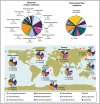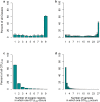Diversity and Biogeography of Bathyal and Abyssal Seafloor Bacteria
- PMID: 26814838
- PMCID: PMC4731391
- DOI: 10.1371/journal.pone.0148016
Diversity and Biogeography of Bathyal and Abyssal Seafloor Bacteria
Abstract
The deep ocean floor covers more than 60% of the Earth's surface, and hosts diverse bacterial communities with important functions in carbon and nutrient cycles. The identification of key bacterial members remains a challenge and their patterns of distribution in seafloor sediment yet remain poorly described. Previous studies were either regionally restricted or included few deep-sea sediments, and did not specifically test biogeographic patterns across the vast oligotrophic bathyal and abyssal seafloor. Here we define the composition of this deep seafloor microbiome by describing those bacterial operational taxonomic units (OTU) that are specifically associated with deep-sea surface sediments at water depths ranging from 1000-5300 m. We show that the microbiome of the surface seafloor is distinct from the subsurface seafloor. The cosmopolitan bacterial OTU were affiliated with the clades JTB255 (class Gammaproteobacteria, order Xanthomonadales) and OM1 (Actinobacteria, order Acidimicrobiales), comprising 21% and 7% of their respective clades, and about 1% of all sequences in the study. Overall, few sequence-abundant bacterial types were globally dispersed and displayed positive range-abundance relationships. Most bacterial populations were rare and exhibited a high degree of endemism, explaining the substantial differences in community composition observed over large spatial scales. Despite the relative physicochemical uniformity of deep-sea sediments, we identified indicators of productivity regimes, especially sediment organic matter content, as factors significantly associated with changes in bacterial community structure across the globe.
Conflict of interest statement
Figures




Similar articles
-
Global dispersion and local diversification of the methane seep microbiome.Proc Natl Acad Sci U S A. 2015 Mar 31;112(13):4015-20. doi: 10.1073/pnas.1421865112. Epub 2015 Mar 16. Proc Natl Acad Sci U S A. 2015. PMID: 25775520 Free PMC article.
-
Diversity of prokaryotes and methanogenesis in deep subsurface sediments from the Nankai Trough, Ocean Drilling Program Leg 190.Environ Microbiol. 2004 Mar;6(3):274-87. doi: 10.1111/j.1462-2920.2004.00568.x. Environ Microbiol. 2004. PMID: 14871211
-
Bacterial diversity in deep-sea sediments under influence of asphalt seep at the São Paulo Plateau.Antonie Van Leeuwenhoek. 2020 May;113(5):707-717. doi: 10.1007/s10482-020-01384-8. Epub 2020 Jan 16. Antonie Van Leeuwenhoek. 2020. PMID: 31950303
-
Hydrocarbon seepage in the deep seabed links subsurface and seafloor biospheres.Proc Natl Acad Sci U S A. 2020 May 19;117(20):11029-11037. doi: 10.1073/pnas.2002289117. Epub 2020 Apr 30. Proc Natl Acad Sci U S A. 2020. PMID: 32354993 Free PMC article.
-
The life sulfuric: microbial ecology of sulfur cycling in marine sediments.Environ Microbiol Rep. 2017 Aug;9(4):323-344. doi: 10.1111/1758-2229.12538. Epub 2017 May 5. Environ Microbiol Rep. 2017. PMID: 28419734 Free PMC article. Review.
Cited by
-
Diversity of Pelagic and Benthic Bacterial Assemblages in the Western Pacific Ocean.Front Microbiol. 2020 Sep 10;11:1730. doi: 10.3389/fmicb.2020.01730. eCollection 2020. Front Microbiol. 2020. PMID: 33071990 Free PMC article.
-
Sediment Microbial Diversity of Three Deep-Sea Hydrothermal Vents Southwest of the Azores.Microb Ecol. 2017 Aug;74(2):332-349. doi: 10.1007/s00248-017-0943-9. Epub 2017 Jan 31. Microb Ecol. 2017. PMID: 28144700
-
Response of Bacterial Communities to Different Detritus Compositions in Arctic Deep-Sea Sediments.Front Microbiol. 2017 Feb 24;8:266. doi: 10.3389/fmicb.2017.00266. eCollection 2017. Front Microbiol. 2017. PMID: 28286496 Free PMC article.
-
Influence of 16S rRNA Hypervariable Region on Estimates of Bacterial Diversity and Community Composition in Seawater and Marine Sediment.Front Microbiol. 2019 Jul 16;10:1640. doi: 10.3389/fmicb.2019.01640. eCollection 2019. Front Microbiol. 2019. PMID: 31379788 Free PMC article.
-
Bacterial symbiont diversity in Arctic seep Oligobrachia siboglinids.Anim Microbiome. 2023 Jun 1;5(1):30. doi: 10.1186/s42523-023-00251-x. Anim Microbiome. 2023. PMID: 37264469 Free PMC article.
References
-
- Rex MA, Etter RJ. Deep-sea biodiversity—pattern and scale Cambridge: Harvard University Press; 2010.
-
- Jørgensen BB, Boetius A. Feast and famine—microbial life in the deep-sea bed. Nat Rev Microbiol. 2007;5(10):770–81. 2007-211LO-0011. - PubMed
-
- Boetius A, Wenzhofer F. Seafloor oxygen consumption fuelled by methane from cold seeps. Nature Geosci. 2013;6(9):725–34. 10.1038/ngeo1926 - DOI
Publication types
MeSH terms
Substances
LinkOut - more resources
Full Text Sources
Other Literature Sources

